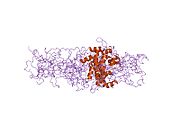GJA1
Ensembl | |||||||||
|---|---|---|---|---|---|---|---|---|---|
| UniProt | |||||||||
| RefSeq (mRNA) | |||||||||
| RefSeq (protein) | |||||||||
| Location (UCSC) | Chr 6: 121.44 – 121.45 Mb | Chr 10: 56.25 – 56.28 Mb | |||||||
| PubMed search | [3] | [4] | |||||||
| View/Edit Human | View/Edit Mouse |
| Connexin43 | |||||||||
|---|---|---|---|---|---|---|---|---|---|
TCDB 1.A.24 | | ||||||||
| |||||||||
Gap junction alpha-1 protein (GJA1), also known as connexin 43 (Cx43), is a protein that in humans is encoded by the GJA1 gene on chromosome 6.[5][6][7] As a connexin, GJA1 is a component of gap junctions, which allow for gap junction intercellular communication (GJIC) between cells to regulate cell death, proliferation, and differentiation.[8] As a result of its function, GJA1 is implicated in many biological processes, including muscle contraction, embryonic development, inflammation, and spermatogenesis, as well as diseases, including oculodentodigital dysplasia (ODDD), heart malformations, and cancers.[7][9][10]
Structure
GJA1 is a 43.0 kDa
The connexin-43 internal ribosome entry site is an
| Connexin-43 internal ribosome entry site (IRES) | |
|---|---|
| SO | SO:0000243 |
| PDB structures | PDBe |
Function

As a member of the
GJA1 is the most ubiquitously expressed connexin and is detected in most cell types.[7][9][12] It is the major protein in
Furthermore, GJA1 is expressed in many
In addition, GJA1 can be found in the
While it is a channel protein, GJA1 can also perform channel-independent functions. In the
Clinical significance
Notably, GJA1 expression has been associated with a wide variety of cancers, including
The
Currently, only
Interactions
Gap junction protein, alpha 1 has been shown to
- Cx37,[12]
- Cx40,[12]
- Cx45,[12]
- MAPK7,[20]
- Caveolin 1,[21]
- Tight junction protein 1[22]
- CSNK1D,[23] and
- PTPmu (PTPRM).[24]
See also
References
- ^ a b c GRCh38: Ensembl release 89: ENSG00000152661 – Ensembl, May 2017
- ^ a b c GRCm38: Ensembl release 89: ENSMUSG00000050953 – Ensembl, May 2017
- ^ "Human PubMed Reference:". National Center for Biotechnology Information, U.S. National Library of Medicine.
- ^ "Mouse PubMed Reference:". National Center for Biotechnology Information, U.S. National Library of Medicine.
- PMID 10331943.
- PMID 1646158.
- ^ a b c d e f g "Entrez Gene: GJA1 gap junction protein, alpha 1, 43kDa".
- ^ S2CID 28968035.
- ^ S2CID 11855947.
- ^ PMID 25110696.
- ^ "Protein sequence of human GJA1 (Uniprot ID: P17302)". Cardiac Organellar Protein Atlas Knowledgebase (COPaKB). Archived from the original on 5 October 2015. Retrieved 18 September 2015.
- ^ S2CID 20651016.
- ^ PMID 22155212.
- S2CID 26020820.
- ^ PMID 25843295.
- ^ Boros-Rausch, A., Shynlova, O., & Lye, S. J. (2021). "A Broad-Spectrum Chemokine Inhibitor Blocks Inflammation-Induced Myometrial Myocyte-Macrophage Crosstalk and Myometrial Contraction". Cells. 11 (1): 128. doi: 10.3390/cells11010128 PMID: 35011690
- S2CID 13345970.
- S2CID 205620477.
- PMID 36046184.
- PMID 12637502.
- PMID 11980479.
- S2CID 6434044.
- PMID 12270943.
- PMID 14681016.
Further reading
- Harris AL, Locke D (2009). Connexins, A Guide. New York: Springer. p. 574. ISBN 978-1-934115-46-6.
- Saffitz JE, Laing JG, Yamada KA (Apr 2000). "Connexin expression and turnover : implications for cardiac excitability". Circulation Research. 86 (7): 723–728. PMID 10764404.

